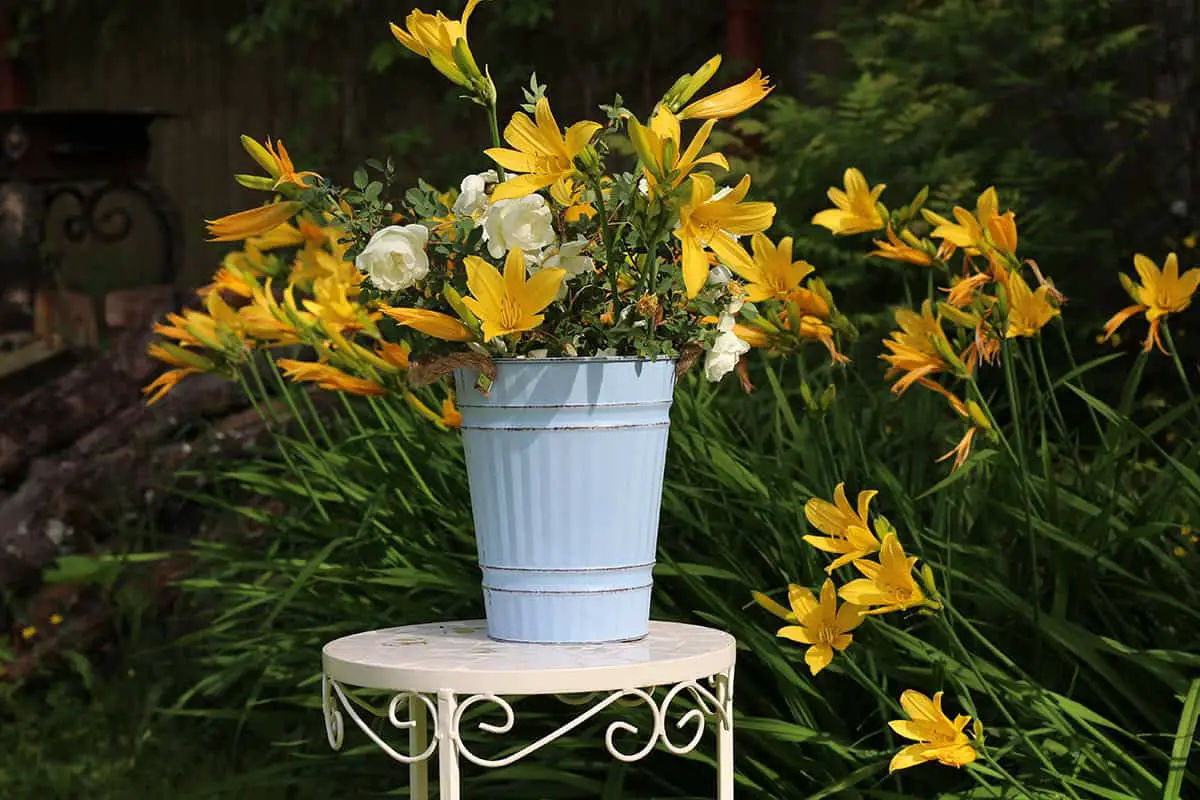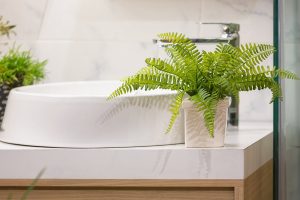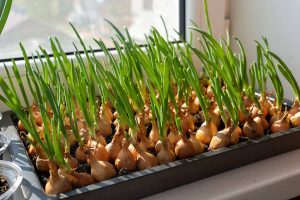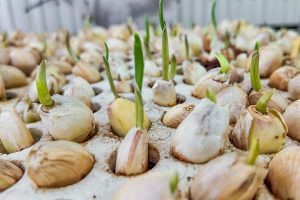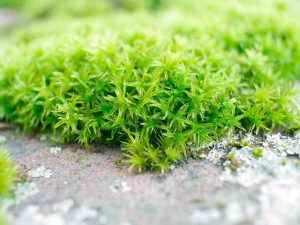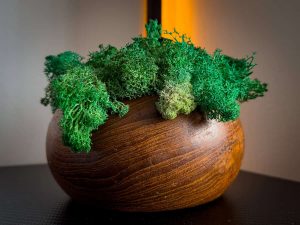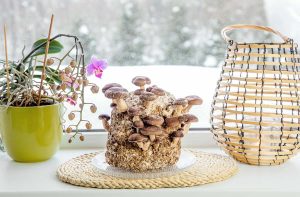Not everyone has sprawling garden beds to play with—but that doesn’t mean you can’t enjoy lush, thriving plants year after year. Perennials in pots are the perfect solution for small patios, balconies, and compact yards. Here are 20 beautiful perennials that flourish in containers and bring lasting charm to limited garden spaces.
Table of Contents
Hostas
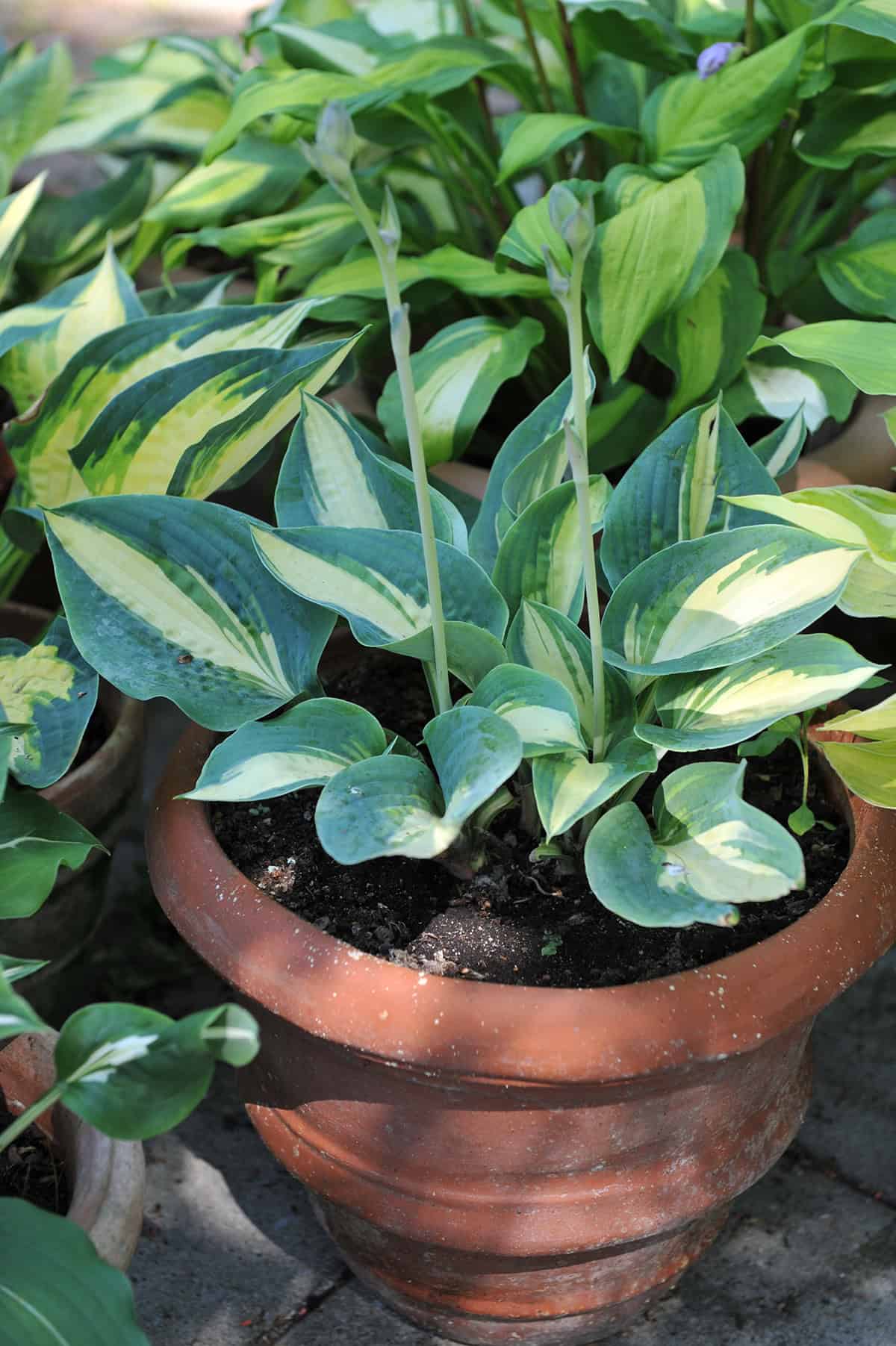
Few plants fill a shady corner quite like hostas. Their leaves alone can carry a container display, with endless variations in shape, size, and color — from glossy deep greens to variegated whites and golds.
Depending on the variety, you might tuck a miniature hosta into a small pot or dedicate a larger container to one of the big, dramatic types. That flexibility makes them useful whether you’re working with a balcony, patio, or a more traditional garden setting.
Good drainage is important, so don’t skimp on the choice of container. Rich, well-drained soil keeps the roots happy, and a steady routine of watering with an occasional boost of fertilizer will keep the foliage looking full through the season.
Sunlight is where many gardeners go wrong. These plants love shade and will tolerate only gentle, indirect light — too much sun and the leaves scorch.
A grouping of hostas can soften the look of a paved patio, or a single large specimen can act as a leafy statement piece. Varieties like H. sieboldiana ‘Elegans’ show off oversized, textured leaves and even fragrant blooms, but you’ll want a roomy pot if you choose this one.
Lavender
Lavender likes its pots roomy and the soil gritty—sandy loam with a bit of compost works wonders. Don’t skip the drainage holes, or you’ll end up with mushy roots.
Keep the soil pH between 6.5 and 8; if it’s too acidic, a sprinkle of lime helps. Lavender’s a sun worshipper, so find a spot that gets 6 to 8 hours of direct light a day if you want those fragrant blooms.
Go easy on the watering. Let the soil dry out a bit between drinks. Too much moisture is a fast track to root rot.
Prune back by about a third in spring—don’t get carried away or you’ll shock the plant. Each year, consider repotting into something just a size up, with fresh mix, to keep it from getting tired.
With a little winter protection, lavender even gets through colder climates (USDA zones 5 to 7). It’s surprisingly tough if you don’t smother it with attention.
Coral Bells (Heuchera)
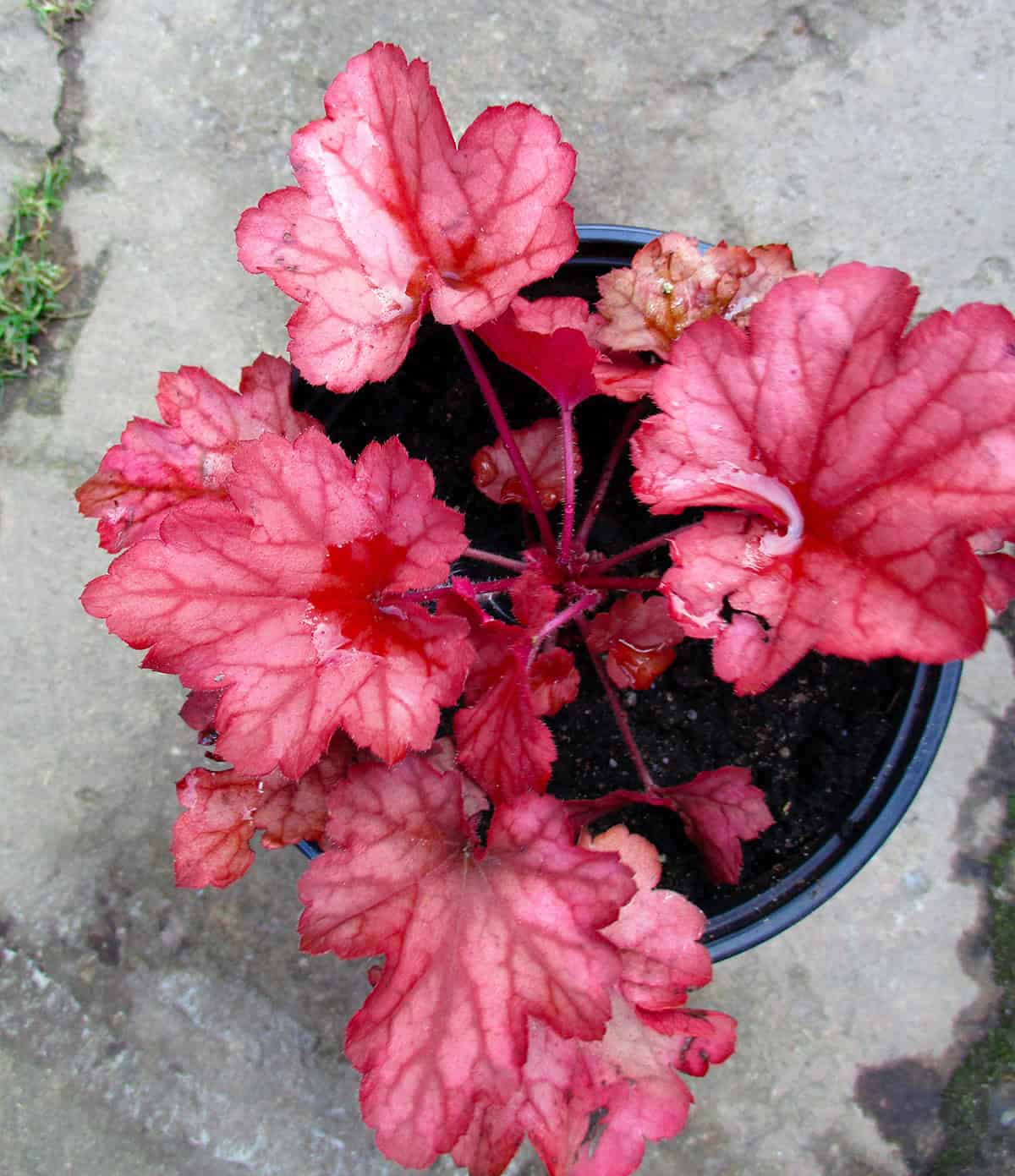
If you like container gardening, Coral Bells are a great choice. They are low-maintenance and easy to grow. You can even use them to complement other plants in your garden.
Heuchera prefers morning sunlight and afternoon shade. Weekly watering is needed if the weather is hot and dry. Use mulch like pine straw or shredded bark to conserve soil moisture.
You can grow Coral Bells in various environments. They do well in woodlands, rock gardens, and containers. Their foliage comes in many colors like green, purple, and silver. Some leaves have marbled patterns and dramatic veining.
Coral Bells are not just pretty. They are also versatile and resilient. They are native to North America and can handle different soil types. They have evergreen to semi-evergreen foliage and will provide your garden with year-round interest.
Sedum (Stonecrop)
Stonecrops are rugged little perennials with thick, succulent leaves—sometimes flat, sometimes round. Some, like Hylotelephium telephium, grow up to 2.5 feet, sporting clusters of starry pink or purplish-red flowers.
Varieties like SunSparkler® are favorites for their flashy foliage and hot pink to red blooms. They shrug off drought and love life in a pot—perfect if you want something low-key.
They’re happiest in lean, sandy soil with sharp drainage. Water sparingly. Want more? Just snap off a stem or leaf and root it—stonecrops are ridiculously easy to propagate.
Creeping types like Sedum sarmentosum form mats of yellow-green, adding a different texture if you’re after ground cover or a trailing look in containers.
Daylilies
Daylilies perform well in pots and bring bright, vibrant colors to any space. Known for their hardiness, daylilies can tolerate a variety of conditions and still thrive.
One key advantage of growing daylilies in pots is their adaptability. They do well in many soil types and light conditions. Their ability to establish quickly and grow vigorously makes them ideal for containers.
Daylilies bloom from summer until the first frost. Each flower lasts just one day, but the plant produces an abundance of blooms over several weeks. This ensures continuous color in your container garden.
You can choose from a wide variety of daylilies. They come in various colors, including yellow, orange, red, pink, purple, and creamy white. This variety makes it easy to find a type that fits your aesthetic.
When planting daylilies in containers, consider using smaller cultivars. They are more manageable and suitable for pot growth. Make sure the container is large enough to support the plant’s root system.
Daylilies also have the added benefit of being relatively pest-free. This makes them low-maintenance and simple to care for compared to other flowers.
Salvia
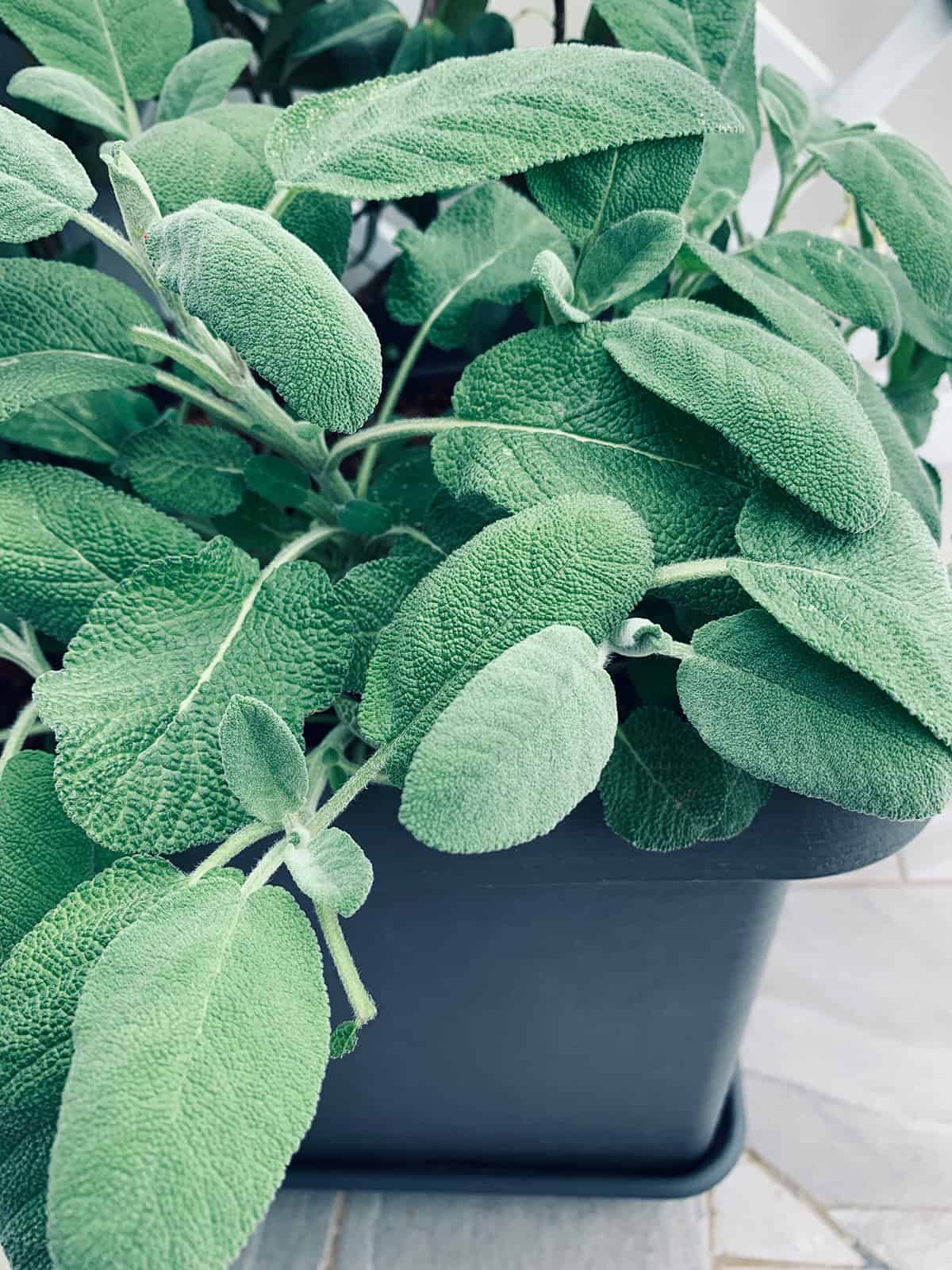
Few plants earn their keep in pots quite like salvias. They thrive on sun and well-drained soil, and when they bloom, the colors span nearly the whole spectrum — blues, purples, pinks, reds, whites, and even cheerful yellows. Add in that pleasant, herbal fragrance from the leaves, and you’ve got a plant that appeals to more than just the eyes.
Pollinators are drawn to them in droves. Hummingbirds hover at the tubular flowers, butterflies drift in for nectar, and bees keep busy among the blooms. For best results, set containers where they’ll get at least six hours of direct light and water regularly, keeping the soil moist but never soggy.
A little feeding goes a long way. Mix slow-release fertilizer into the potting soil at the start, then supplement with a weekly dose of liquid feed to keep the flowers coming. Salvias adapt well, and once they’re established, they’ll shrug off the occasional dry spell.
They’re also generous plants if you like to share. Snip a cutting, and it will usually root without much effort, giving you more plants for your own garden or gifts for friends. With their resilience, color, and pollinator-friendly nature, salvias are one of the easiest perennials to recommend for container gardening.
Coreopsis
Coreopsis is a no-brainer for pots if you want a shot of color on the patio or balcony. Some types get up to 4 feet, others stay closer to 2-3 feet—pick what fits your space.
They want full sun and don’t need much water. Let the soil dry out before watering again. Deadhead spent blooms and you’ll get flowers from late spring into fall.
Go for pots at least 16 inches deep so the roots can really dig in. Drainage is key—rich soil can make stems floppy, so don’t overdo it.
Mixing them with other perennials that flower at different times is a smart way to keep the color going. Coreopsis is adaptable and doesn’t ask for much, just a sunny spot and the occasional drink.
Astilbe
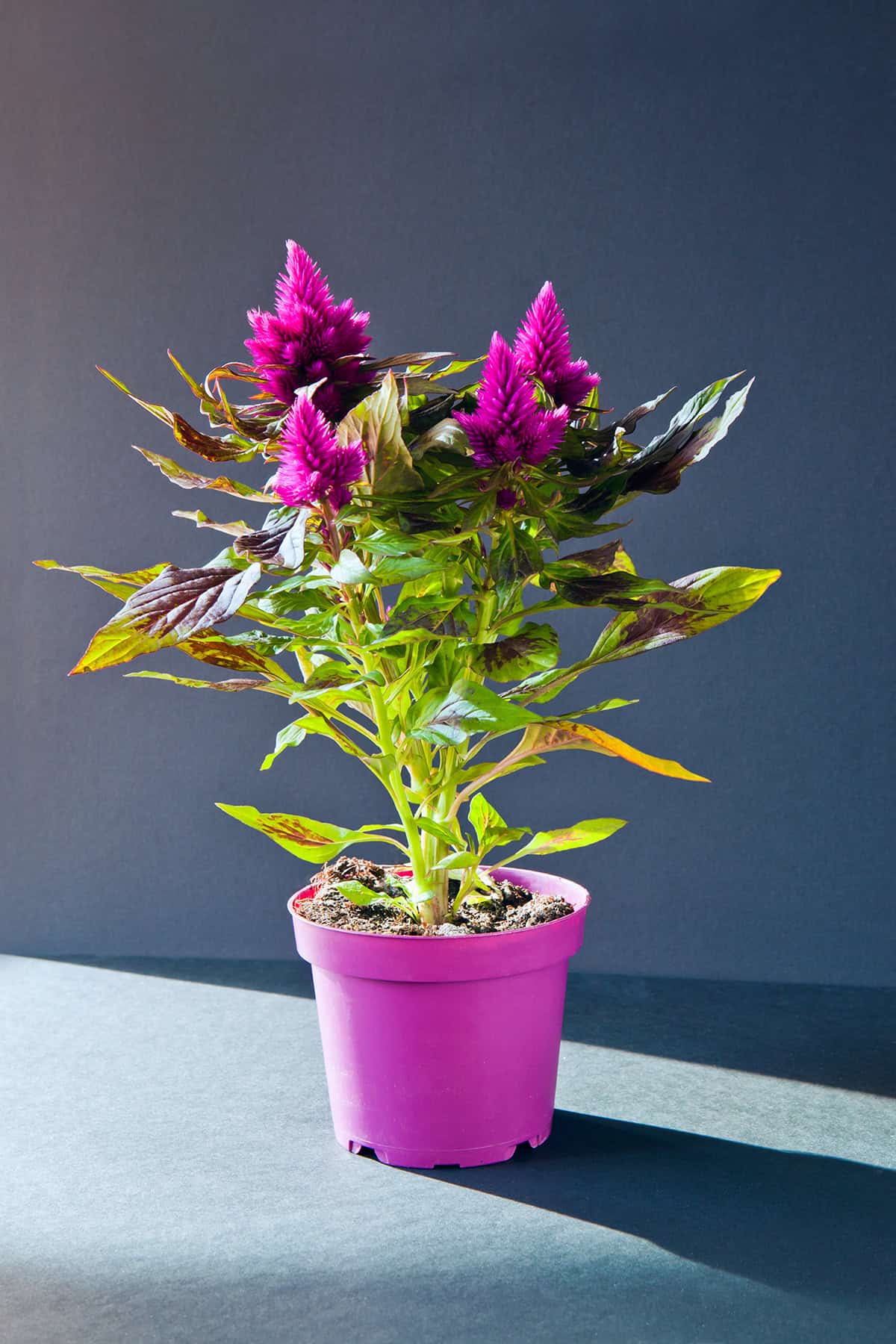
Astilbe puts out feathery plumes in shades from white to pink, red, and purple—great for brightening up shady corners. They like their soil moist but well-drained and do best with a bit of afternoon shade to keep blooms from fading.
In pots, give them at least a 16-inch-wide, 12-inch-deep container. Bigger pots let you group plants for a fuller look, and you can move them around to chase shade or dodge hot spells.
Hybrids like Astilbe x arendsii, bred from species like A. chinensis and A. japonica, usually reach two to three feet and are favorites for cut or dried arrangements.
Divide every 4 to 6 years to keep them vigorous. After splitting, water well and mulch to help them settle in.
Astilbe biternata is a real standout—almost 6 feet tall, with bold, ferny leaves. It’s dramatic, especially in woodland-style plantings.
Dianthus
Dianthus comes in all forms—annuals, biennials, perennials—ranging from tiny ground-huggers to plants nearly three feet tall. Most garden types stay around 10 to 20 inches. Sweet Williams, carnations, and Pinks are some of the better-known names in the group.
They’re sun lovers but won’t sulk if they get a little shade, and cooler weather brings out the best blooms. Some, like Jolt™ Pink, are bred for heat resistance and stand-out color.
For containers, drainage is non-negotiable. The petals are edible if you skip the pesticides—toss them on salads if you’re feeling fancy—but the leaves aren’t great for eating.
Japanese Anemone
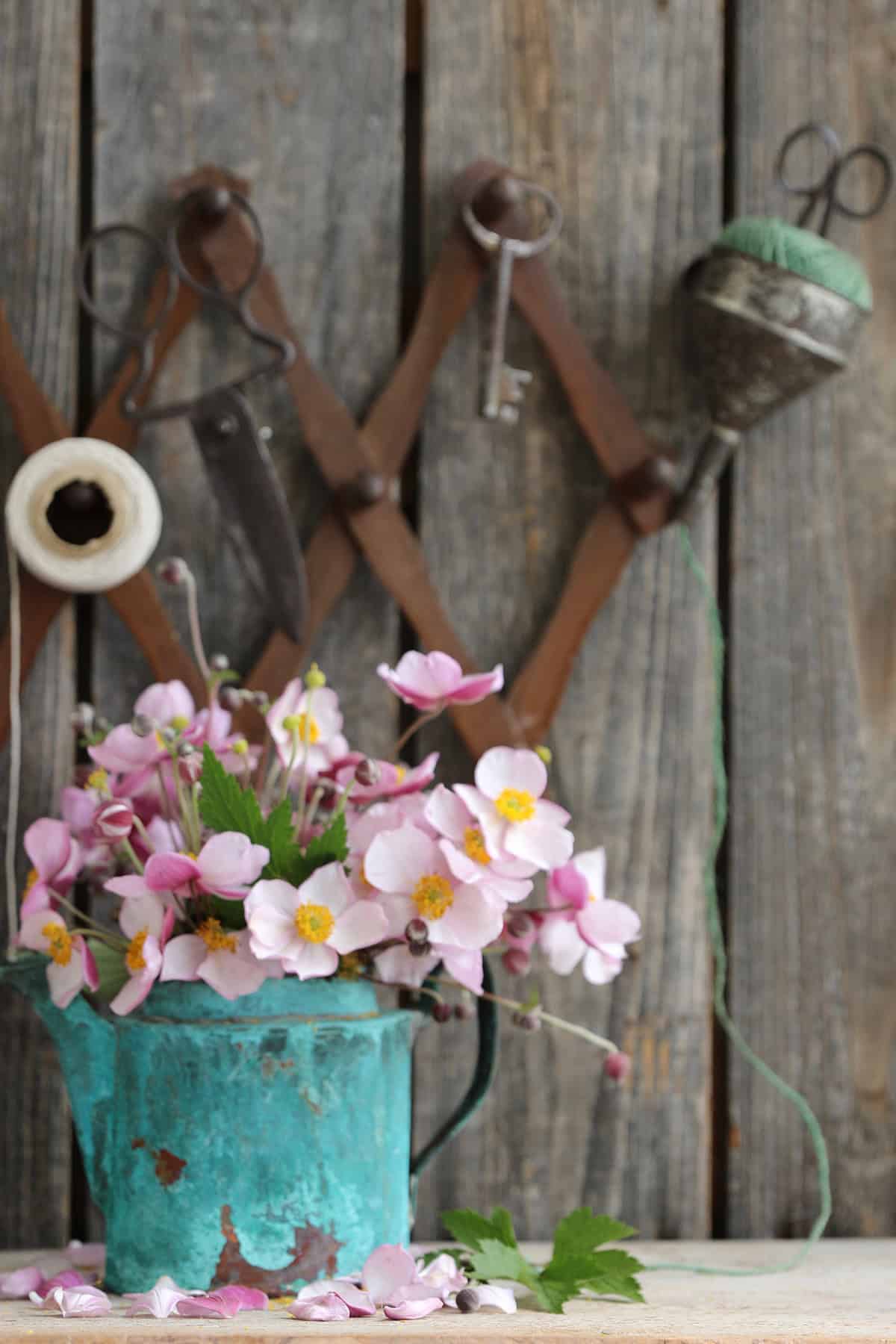
Japanese anemones bring elegance with their white or pink, two- to three-inch blooms—perfect for pots. They like soil that drains well; too much moisture spells trouble for their roots. Keep them evenly moist in summer for best growth.
They’re hardy down to USDA zone 4 and handle a range of climates. Divide or transplant in spring or fall, which works well for container growing. Their graceful look pairs nicely with other shade lovers or under trees.
They can get a bit too enthusiastic, so keep an eye out—regular pruning and checking their spread is wise. If you buy from a nursery in autumn, they’ll have time to settle before the next growing season.
Bleeding Heart
This perennial is known for its dainty, heart-shaped pink and white flowers, happiest in partial shade. Moist but well-drained soil is the goal—never soggy, especially in winter. Tucking it near taller plants or along patio edges gives it a nice stage.
The ferny leaves add a soft texture, but by late summer, they’ll go dormant. Pairing with shade lovers like hostas or ferns keeps the pot looking good when the flowers fade. Water regularly, but don’t go overboard, and feed with a balanced fertilizer in spring for strong growth.
Once it goes dormant, fill gaps with annuals like impatiens for extra color. They’re pretty tough, but check for aphids now and then to keep them happy.
Hellebores
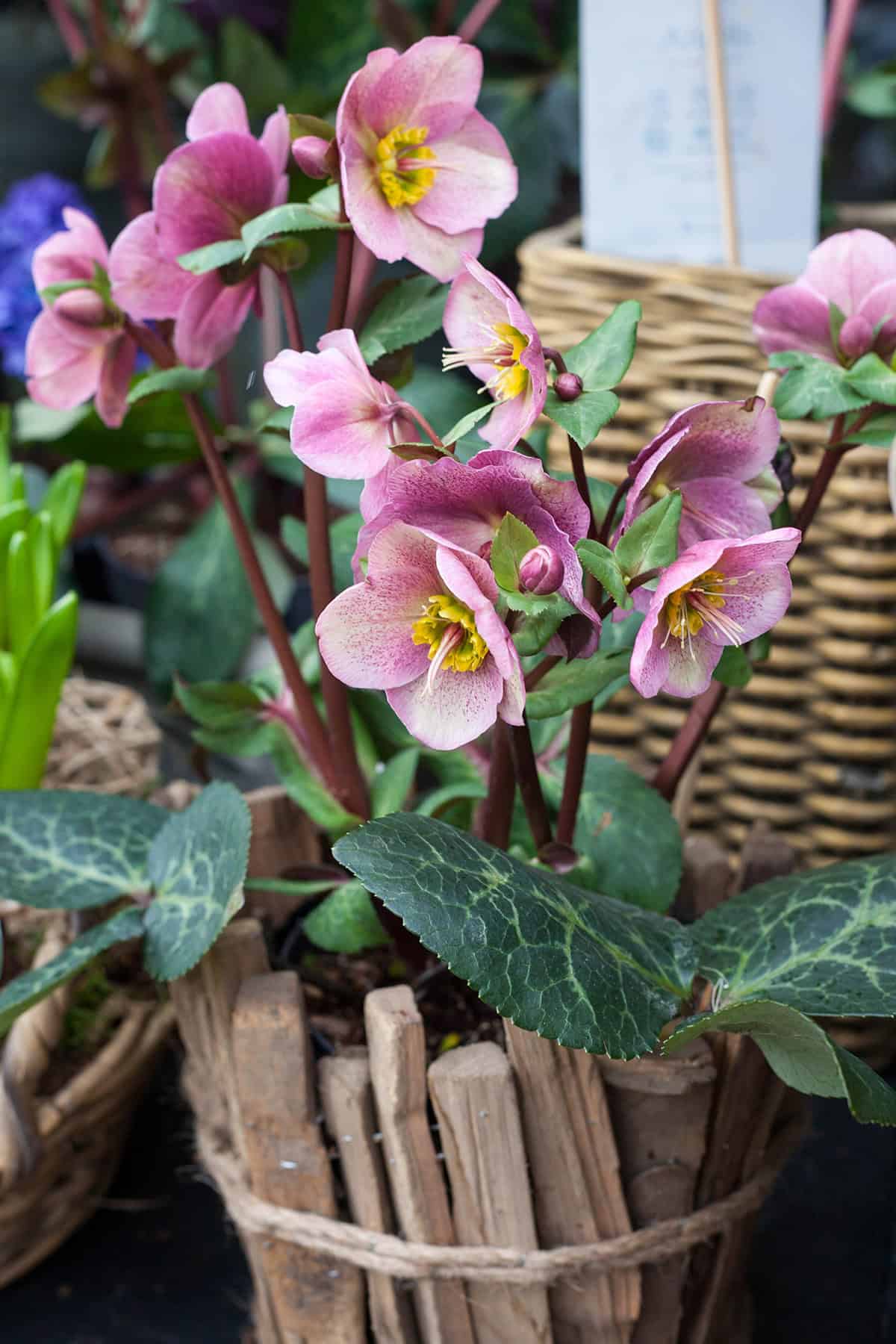
Hellebores bloom in winter and early spring, brightening the garden when little else is awake. They’re part of the buttercup family and work well in USDA zones 4 through 9.
For containers, pick a big pot with solid drainage. Use rich, well-draining soil so roots don’t get soggy. Shade or dappled sun is best—think of where they’d grow naturally.
Water consistently but don’t drown them. Hellebores are tough, shrug off most pests, and don’t need much attention once settled.
Hybrids offer a rainbow of flower colors, making them a highlight in cold months. Most handle freezing temps without batting an eye.
Gaillardia (Blanket Flower)
With its cheery, daisy-like flowers splashed in red, orange, and yellow, this plant is a favorite for containers. Part of the Asteraceae family, it does best where the sun is strong and steady.
Hybrids like Gaillardia x grandiflora mix traits from annuals and perennials, so you get a long stretch of blooms—even though the plant itself isn’t especially long-lived. Deadheading spent flowers helps keep the show going.
It’s picky about drainage; soggy roots are a no-go. Water consistently, but don’t drown it. Once it’s settled in, it can handle drought and heat surprisingly well, so it’s a solid pick for hot, dry spots.
Cultivars offer a range of looks—‘Tizzy’ has trumpet-like petals, while ‘Oranges & Lemons’ brings a jolt of color contrast. Mixing a few of these with other sun-lovers in pots makes for a lively, lasting arrangement.
Echinacea (Coneflower)
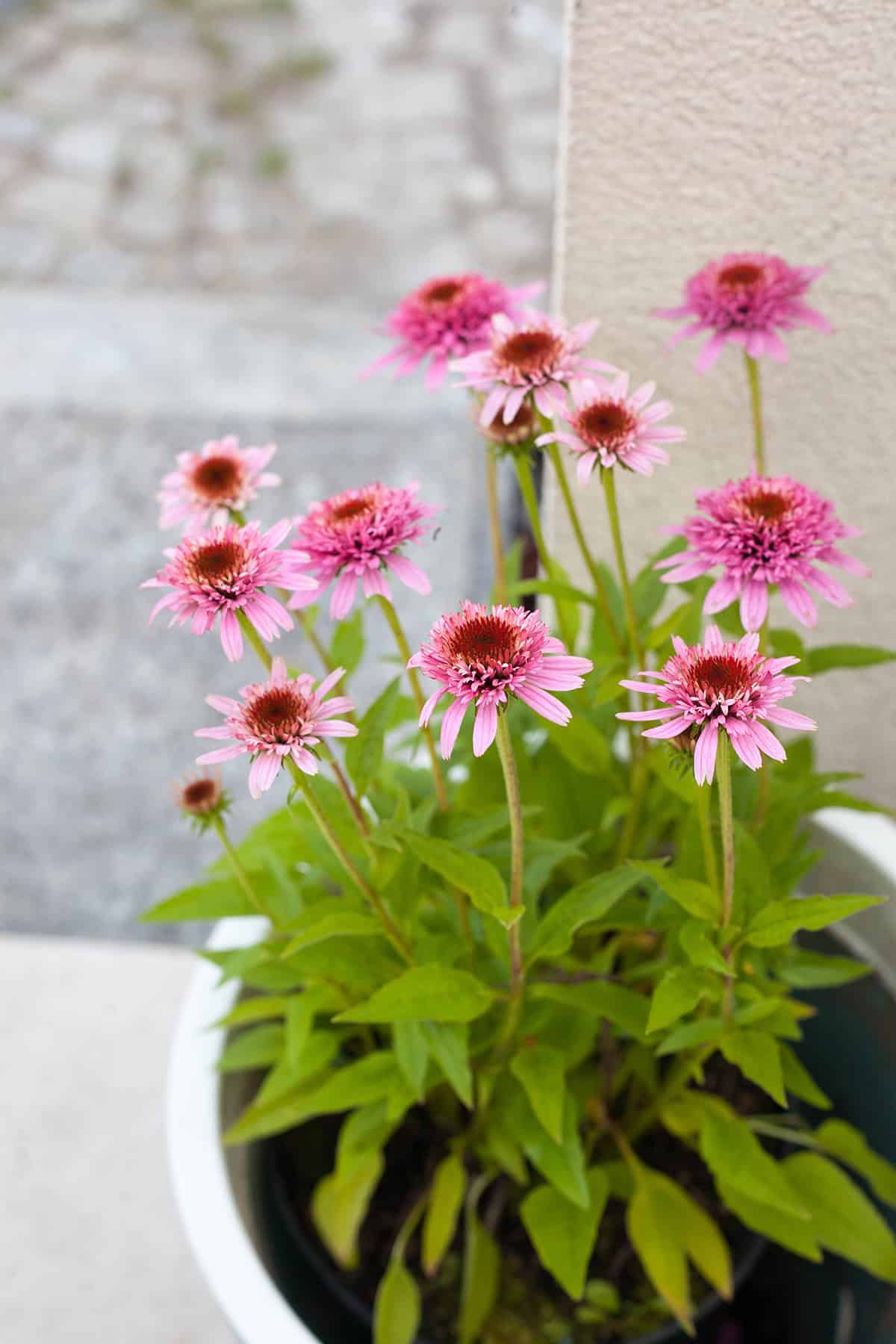
Coneflowers can be quite happy in pots, provided there’s enough space for roots and drainage. They seem to prefer a loamy soil that holds some moisture but doesn’t stay soggy—commercial potting mixes do the trick for most folks.
Feed them with a slow-release fertilizer or compost in spring to keep growth steady. Once they’re established, they’re pretty low-maintenance, and that’s appealing whether you’re new to gardening or have been at it for years.
Their bold purple petals and spiky centers really stand out, and they’re a magnet for butterflies. That prickly “cone” actually inspired their name, which comes from the Greek for “hedgehog.” Native to the eastern and central US, they’re tough enough for most climates.
Hardy Geraniums
Hardy geraniums are excellent choices for potted perennial gardens. They are true perennials, unlike annual geraniums (Pelargonium). You can find a wide variety of species in the marketplace.
These plants thrive in well-drained soil and tolerate partial shade. For the best blooms, ensure they receive at least six hours of direct sunlight daily. Fertilize them with an all-purpose garden fertilizer like 10-10-10 before planting.
Notable Varieties:
- Geranium x cantabrigiense ‘Biokovo’: Chosen as the Perennial Plant of the Year for 2015, this variety boasts white blooms with pink veins. It’s native to the Dalmatia region in Croatia.
- Geranium maculatum: Also known as wild geranium, it’s native to Iowa woodlands and produces charming pink to purple flowers.
When growing hardy geraniums in pots, use containers with good drainage to prevent waterlogging. Choose terracotta or ceramic pots, which allow the roots to breathe. Water regularly but avoid over-watering.
Hardy geraniums serve well in hanging baskets, window boxes, or larger pots. Their compact size and pleasant blooms can brighten any outdoor space.
You can propagate hardy geraniums through cuttings or division. In the fall, transplant the cuttings into larger pots to ensure they develop strong root systems. Use sterile tools to prevent disease spread.
Yarrow
There’s a rugged charm to yarrow, with its airy foliage and bright clusters of blooms. The flowers can be creamy white, blushing pink, bold red, or warm gold, and the plants themselves range from compact little mounds to statuesque clumps nearly four feet tall.
Each type has its quirks. Common yarrow typically tops out at about three feet with white to red blooms. Fern leaf yarrow is taller, often in golden hues. Woolly yarrow stays close to the ground, with its gray fuzzy leaves and sunny flowers, making it a fun option for edging or spilling from a container.
In pots, yarrow does best with plenty of sun and soil that drains quickly — think sandy or gritty mixes rather than heavy compost. Choose a container deep enough for its spreading roots, and resist the urge to overwater; once established, it prefers a drier rhythm. Adding a layer of gravel at the bottom of the pot can help avoid soggy conditions.
Butterflies and bees flock to the flowers, and the plant looks right at home in naturalistic arrangements. Pair a taller yarrow with ornamental grasses for a meadow feel, or tuck a dwarf variety into a smaller pot for a punch of color on a patio. It’s a no-fuss perennial that thrives in containers and brings plenty of life with very little care.
Shasta Daisy
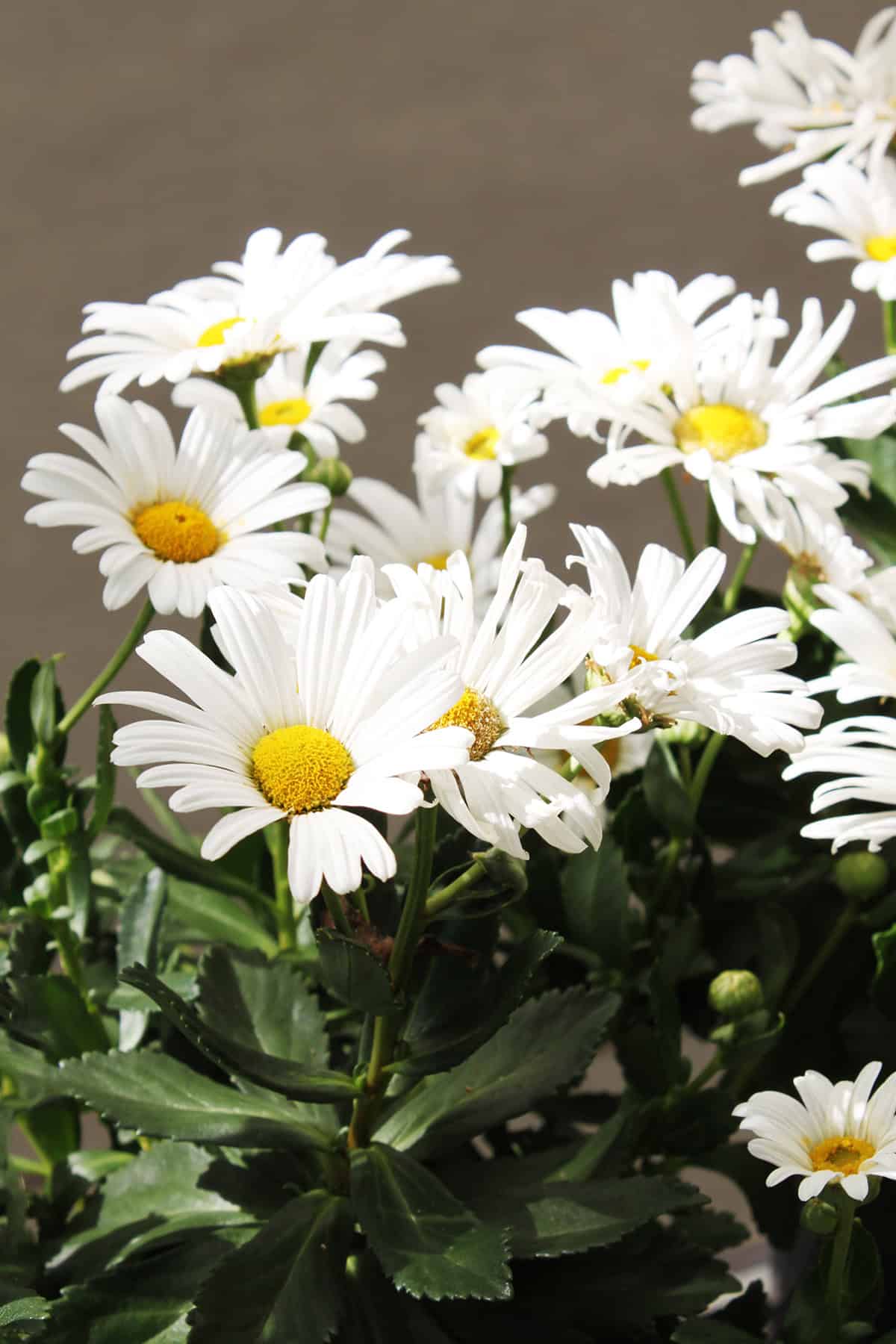
Few flowers feel as classic as Shasta daisies, with their crisp white petals and golden centers. They thrive in full sun but can manage a touch of light shade without complaint. Good drainage is key, and a bit of mulch helps the soil stay cool and moist around the roots.
Most varieties grow between one and three feet tall, and you can find everything from simple single-flowered types to frilly doubles. When grown in containers, choose a pot that’s at least a foot deep so the roots have room to stretch, and water regularly — but never let the soil stay soggy. Root rot is the quickest way to lose them.
The bloom season runs from late spring into summer, and if you snip away the spent flowers, new buds keep appearing. In return, you’ll enjoy vase-ready blooms that last beautifully indoors. Deer usually pass them by, though every once in a while they take a nibble.
On patios and balconies, Shasta daisies bring an easy brightness. Let the soil dry slightly between waterings, and give them plenty of sunlight. Do that, and you’ll be rewarded with cheerful, daisy faces that keep the season alive for weeks on end
Bergenia
This evergreen perennial stays low—around a foot tall—so it’s handy for containers or shady corners. The leaves are thick and leathery, sometimes as big as 10 inches long and 8 inches wide, which gives pots a bit of texture and heft.
In spring, upright stems burst with clusters of small, pink flowers that catch the eye and bring in pollinators. Cooler weather can turn the foliage reddish, so it’s got some year-round interest.
It likes well-drained, slightly acidic soil and can handle anything from full sun to partial shade. Water it regularly, but don’t overdo it—soggy roots are trouble.
Bergenia shines in decorative pots on patios or decks. It’s tough and doesn’t need much fussing over, which is great for folks just getting started with gardening.
Rudbeckia (Black-Eyed Susan)
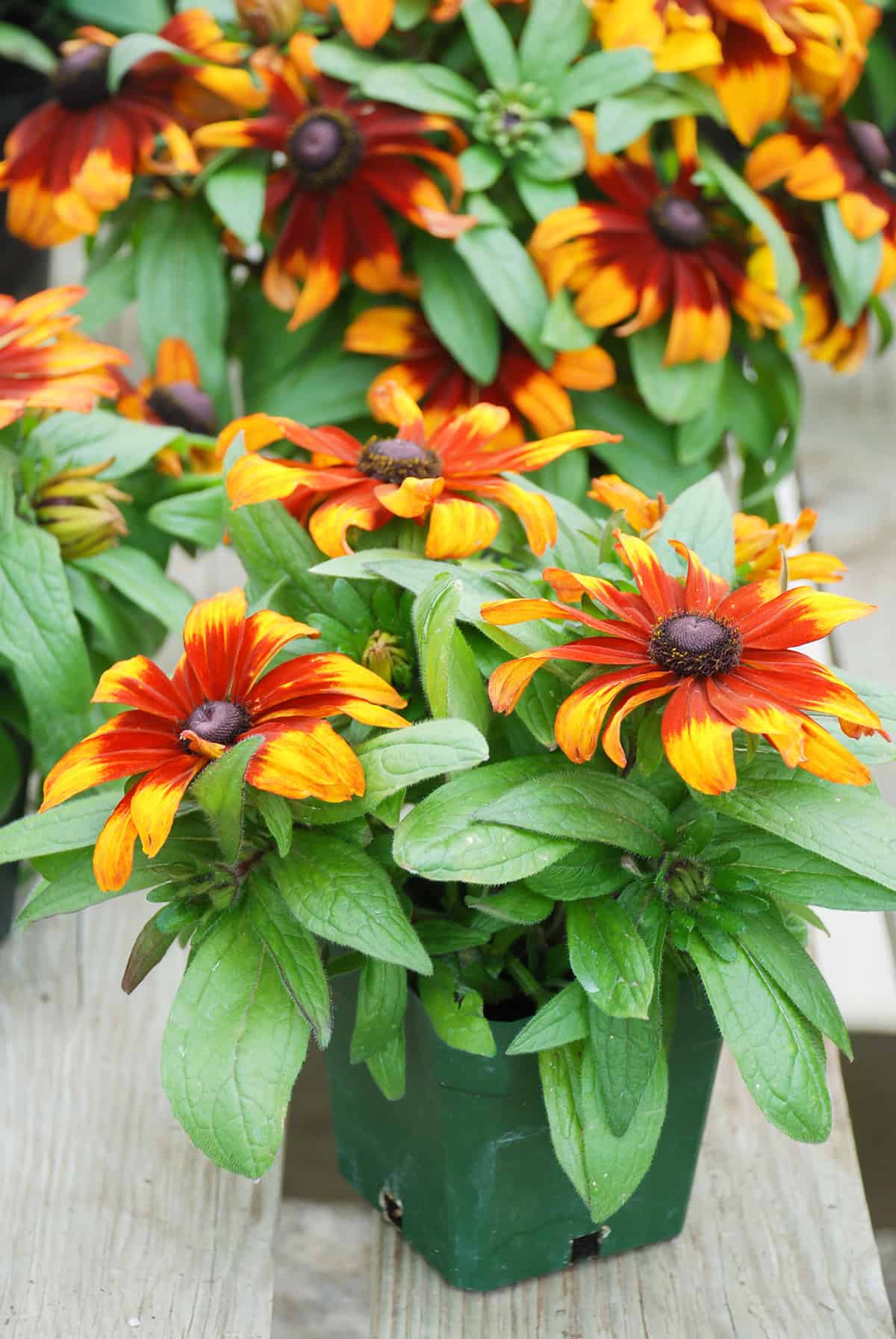
With bold yellow petals and a dark center, this plant is a staple in gardens and looks just as good in containers. It does best in pots with well-draining soil mixed with compost.
Rudbeckia usually grows 2 to 3 feet tall, but the ‘Goldsturm’ variety is more compact and fits nicely in pots. Keep the watering steady, but don’t let the roots get soggy.
Full sun is key for loads of flowers. A balanced fertilizer every month or so keeps it healthy, but don’t overdo it—too much can mean fewer blooms.
Deadheading helps new flowers pop up, and a trim after blooming keeps things tidy. Rudbeckia hirta puts out big, bright flowers, while Rudbeckia triloba offers smaller blooms and is native to eastern North America.
Besides being a pollinator magnet, this plant is tough and keeps going even when the weather cools down. It’s one of those easy wins for both color and resilience.
Ornamental Grasses
There’s something almost magical about ornamental grasses — the way they catch the light, shift with the breeze, and add texture that flowers alone can’t deliver. They’re especially good in containers, which makes them perfect for patios, balconies, or any spot that needs a little movement and grace. Popular choices like Maiden Grass, Feather Reed Grass, and Fountain Grass are favorites because they look impressive without demanding much fuss.
One thing I really like about growing them in pots is the freedom to shuffle things around—chasing the sun or just switching up the look whenever you feel like it. Most of these grasses aren’t too thirsty, but you do want to make sure the soil drains well. Soggy roots are never a good time.
They’re pretty low-maintenance overall. Usually, you just trim them back to about 6-8 inches in late winter and let them do their thing. Keep the soil on the lighter side; honestly, there’s rarely a need to fuss with a bunch of amendments.
What’s cool is how they bring not just visual flair but also that gentle rustling sound and sense of movement—something you don’t always think about until you notice it. Whether you tuck them into a rock garden, stick them near a water feature, or pair them with bold flowers or trailing vines, they just work.
And hey, those sturdy stalks last a long time, so you can even snip a few for indoor arrangements if you’re feeling creative. All in all, these grasses are a solid pick for anyone wanting a little extra life and texture in their garden setup.
